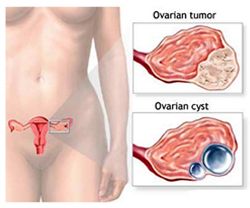
What constitutes ovarian cancer?
Ovarian cancer largely means tumours of epithelial origin, but it can also arise from other elements namely germ cells and stroma. Epithelial ovarian cancers typically occur in postmenopausal women and are in advanced stage at the time of diagnosis, whereas germ cell tumours occur at a young age, are detected in the early stages and are completely curable.
Who are at risk?
The majority of women with ovarian cancer have no known risk factors. Early menarche, late menopause, being over the age of 30 at first childbirth, and nulliparity are said to increase the risk.
What are the protective factors?
Childbirth, breast-feeding, oral contraceptives, tubal ligation, bilateral removal of ovaries (bilateral oophorectomy), and hysterectomy.
What are the symptoms?
Symptoms are non-specific like pelvic pain, back pain, abdominal discomfort, bloating, early satiety, vaginal bleeding, and frequent urination. Ovarian masses are sometimes detected on pelvic examination.
How is it diagnosed?
Transvaginal Ultrasound (TVU) is an important diagnostic tool in evaluation of patients with pelvic mass. Computed Tomography (CT) and Positron Emission Tomography (PET scan) help in defining the extent of the disease. MRI is sometimes helpful. Tumour markers like CA 125 are adjunct to imaging and useful in follow up.
Are all ovarian masses cancers?
All masses in the ovary are not cancers. TVU helps distinguish benign from malignant ovarian cysts. Complex cysts, defined as cysts with both solid and cystic components, septations and echogenicity, are malignant and require exploration. In contrast simple cysts that are thin walled, less than 5-10 cm and without septations are usually benign.
Can we detect ovarian cancer early?
Screening for ovarian cancer has not been successful as natural history of ovarian cancer is not well understood. There is no well-defined precursor lesion and the length of time from localised tumour to dissemination is unknown. Multiple efforts are underway to develop effective screening methods. Pelvic examination, CA 125, and TVU with Doppler are studied as screening methods in high-risk individuals.
Is ovarian cancer genetic?
Around 5-10 per cent of patients carry germline mutation. Breast-ovarian cancer syndrome accounts for approximately 90 per cent of hereditary ovarian cancer and is suspected whenever there are multiple affected family members with ovarian cancer, bilateral or early onset breast cancer, both breast and ovarian cancer in the same individual, or a male relative with breast cancer.
What are the treatment of Ovarian Cancer modalities?
Ovarian Cancer Treatment depends on the age, stage, tumour type and the desire to preserve fertility. Surgery and chemotherapy is the mainstay of treatment.
What complications can I expect after chemotherapy?
The most common early complications are loss of hair, nausea and vomiting. There can be reactions during infusion of chemotherapy, which are prevented with good premedication. Late complications include tingling and numbness in fingers and toes.
How do I prevent ovarian cancer?
Chemoprevention is by oral contraceptives. Surgical prevention is by bilateral oophorectomy, tubal ligation and hysterectomy. Risk-reducing bilateral oophorectomy is strongly recommended in women who carry germline mutation for hereditary ovarian cancer, because of high mortality of ovarian cancer and lack of effective screening and preventive approaches. Fortunately, risk of ovarian cancer does not rise dramatically until the late 30s in women with germline mutation, so women have the opportunity to complete their family prior to surgery. Since ovarian cancer is one of the common cancers in women and there are no effective population screening methods, high index of suspicion is necessary for early diagnosis. With the new trends in chemotherapy, survival is increasing in ovarian cancer patients and awareness is necessary among the public for seeking early medical attention.
For more Information on Ovarian Cancer Treatment in India Please visit this link : https://safemedtrip.com/medical-services/cancer-treatment-in-india/ovarian-cancer-treatment-in-india.html

 Click to WhatsApp
Click to WhatsApp +91-9899993637
+91-9899993637



